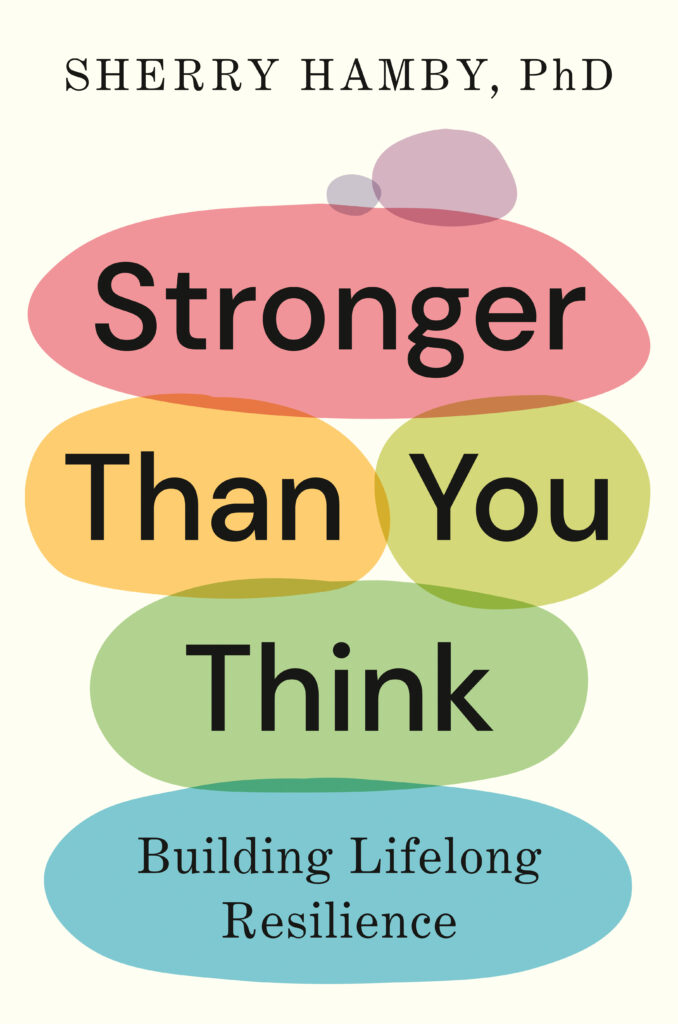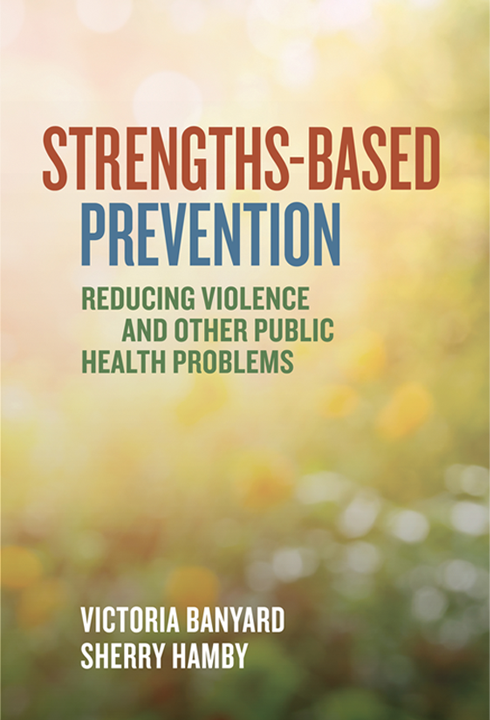
Stronger Than You Think: Building Lifelong Resilience
Publication Date: May 26, 2026
By: Dr. Sherry Hamby
No one is born resilient. But you have the power to become stronger than you think.
At one point or another, life will break us open—through loss, trauma, betrayal, or heartbreak. But as psychologist Dr. Sherry Hamby reveals, we are never beyond repair. We all have an incredible capacity for greater resilience.
In Stronger Than You Think, Dr. Hamby shatters the conventional wisdom that says resilience is something you either have or don’t. Instead, it is a modifiable process—and like any process, it can be learned, practiced, and built upon.
Drawing on over 30 years of original research, clinical work, and a growing body of evidence, this groundbreaking book gives you the tools to build your own resilience portfolio—a set of evidence-based strategies and resources that can help you flourish despite life’s hardest moments. Along the way, you’ll learn:
- The everyday, science-backed practices you can rely on to feel calmer and more regulated
- How cultivating an authentic sense of purpose changes everything—including giving your trauma meaning
- How our social and physical ecologies can make us more or less resilient, and how to make necessary changes
- Why traditional therapy and medication can only take us so far, and how to take it one step further
You don’t have to be tough or gritty to thrive. You just have to know how to build your strength.
STRENGTH-BASED PREVENTION

Banyard, V., & Hamby, S. (Nov 2021). Strengths-based prevention: Reducing violence & other public health problems. Washington, DC: American Psychological Association.
A new way of thinking about prevention that focuses on building assets and resources.
This book provides practitioners and researchers with the means to make more impactful choices in the design and implementation of prevention programs. Drawing from state-of-the-art research on a range of behavior problems such as violence, drug abuse, suicide, and risky sexual activity, Victoria Banyard and Sherry Hamby present a strengths-based approach to prevention. Historically, most prevention efforts have focused too much on admonishment and knowledge transfer, despite years of evidence that such programs are ineffective. Effective prevention must be grounded in a broad understanding of what works, what does not, and how different forms of risky behavior share common elements. This book synthesizes research on behavior change from a variety of disciplines, including psychology, public health, sociology, criminology, resilience science, critical race theory, and even urban planning. It emphasizes the importance of building enough protective strengths to insulate people from risks.
BATTERED WOMEN’S PROTECTIVE STRATEGIES

Hamby, S. (2014). Battered women’s protective strategies: Stronger than you know. New York: Oxford University Press.
Battered Women’s Protective Strategies: Stronger Than You Know challenges the stereotypes that depict battered women as passive and shows how to use the strength of battered women to create better research and intervention. The book also presents a new approach to safety planning for domestic violence, the Victim Inventory of Goals, Options, and Risks (the VIGOR) — [this is under Measures and Tools] — which is based on a well-validated approach called Multiple Criteria Decision Making.
Through an alternative strengths-based framework, Hamby deftly illustrates how battered women are not passive and in denial but are active and diligent in protecting themselves and their loved ones. Domestic violence is not just about physical assault. Many women who experience domestic violence also face the risk of homelessness or the threat of losing custody of their children in a divorce battle. Understanding the full range of risks is necessary to understanding the complex problem of domestic violence. This book reveals a wide range of protective strategies: immediate defensive responses in the moments following an attack, protecting children and other loved ones, reaching out for social support, turning to religious and spiritual resources, and engaging in formal help seeking. Many, many strategies are still largely invisible to providers and researchers, and the steps that women take that receive very little attention or acknowledgement in the domestic violence field. The author identifies the vital role that researchers can play by simply acknowledging the variety of approaches that battered women employ. In this book’s two new studies, survivors of domestic violence identify more than 140 different protective strategies in open-ended questions. These and other insights from survivor testimony make this volume the largest and most comprehensive review of battered women’s strengths to date.
THE WEB OF VIOLENCE:
EXPLORING CONNECTIONS AMONG DIFFERENT FORMS OF INTERPERSONAL VIOLENCE AND ABUSE
EXPLORING CONNECTIONS AMONG DIFFERENT FORMS OF INTERPERSONAL VIOLENCE AND ABUSE

Hamby, S., & Grych, J. (2013). The web of violence: Exploring connections among different forms of interpersonal violence and abuse. New York: Springer.
There is an increasing appreciation of the interconnections among all forms of violence. These interconnections have critical implications for conducting research that can produce valid conclusions about the causes and consequences of abuse, maltreatment, and trauma. The accumulated data on co-occurrence also provide strong evidence that prevention and intervention should be organized around the full context of individuals’ experiences, not narrowly defined subtypes of violence. Managing the flood of new research and practice innovations is a challenge, however. New means of communication and integration are needed to meet this challenge, and the Web of Violence is intended to contribute to this process by serving as a concise overview of the conceptual and empirical work that form a basis for understanding the interconnections across forms of violence throughout the lifespan. It also offers ideas and directions for prevention, intervention, and public policy.
A number of initiatives are emerging to integrate the findings on co-occurrence into research and action. The American Psychological Association established a new journal, Psychology of Violence, which is a forum for research on all types of violence. Sherry Hamby is the founding editor and John Grych is associate editor and co-editor of a special issue on the co-occurrence of violence in 2012. Dr. Hamby also is a co-investigator of the National Survey of Children’s Exposure to Violence (NatSCEV), which has drawn attention to polyvictimization. Polyvictimization is a focus of the U.S. Department of Justice’s Defending Childhood Initiative and has recently been featured in calls for grant proposals by the Office of Victims of Crime and National Institutes for Justice.
Sortir Ensemble et Se Respecter: Prévention des violences et promotion des compétences positives dans les relations amoureuses entre jeunes

De Puy, J., Monnier, S., & Hamby, S. (2009). Sortir Ensemble et Se Respecter: Prévention des violences et promotion des compétences positives dans les relations amoureuses entre jeunes. [Dating with Respect: Prevention of violence and promotion of positive skills in youth dating relationships]. Geneva, Switzerland: IES Éditions.
Romantic relationships are one of the main concerns of teenagers. However, abusive behavior, especially of a verbal and emotional nature, tends to be trivialized by the latter. This attitude turns out to be often linked to adherence to stereotypes about the role of men and women. The “Dating and Respecting” (SEESR) prevention and health promotion program offers, through engaging and fun activities, tools to help young people get off on the right foot from their first romantic experiences. The heart of the book is made up of a program of nine interactive sessions and a methodological animation manual. It is enriched with scientific documentation on violence, adolescence and the prevention of dating violence. The terms of the program were tested and adapted during a feasibility study carried out in French-speaking Switzerland within the framework of the HETS, Geneva. SEESR, taken in its entirety, has been shown to be a promising tool to gradually lead young people towards behavior change, and to help them acquire positive skills.
THE CONFLICT TACTIC SCALES HANDBOOK

Straus, M. A., Hamby, S., & Warren, W. L. (2003). The Conflict Tactic Scales handbook. Los Angeles, CA: Western Psychological Services.
This handbook presents a summary of the principal work that has been carried out in relation to the CTS, one of the most widely used survey tool for research on spousal abuse. It is intended as the primary source of background material and guidance to support the use, in both research and clinical settings, of the most current and recommended forms of the CTS: the Revised Conflict Tactics Scales (CTS2) and the Conflict Tactics Scales: Parent-Child Version (CTSPC). The CTS2 is a survey tool characterizing spousal abuse and the CTSPC is a version recommended for characterizing parent-to-child violence. Administration, scoring and interpretation for both the Revised Conflict Tactics Scales (CTS2) and CTS: Parent-Child Version (CTSPC) are given.
